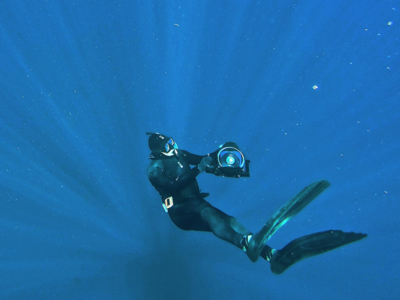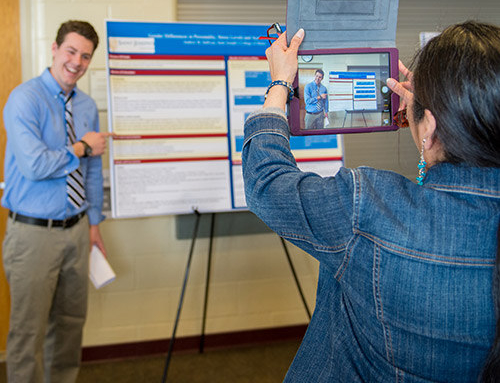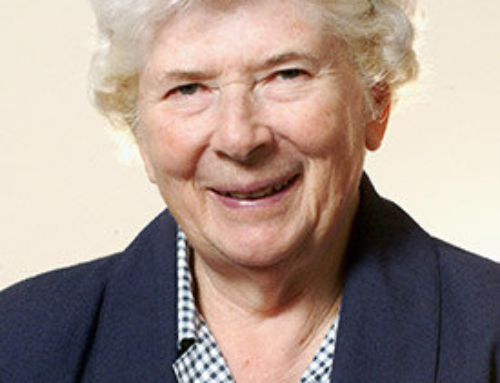 What happens when you transcend your ordinary? It changes your world.
What happens when you transcend your ordinary? It changes your world.
Story by Alanna Conn
Photo by Scott Fuller
Last summer, seven Saint Joseph’s College students—ranging in majors from environmental science to fine arts—headed to Logan International Airport in Boston. Their suitcases, packed tight with wetsuits and waterproof cameras, wheeled along behind them. They were off to Isla Mujeres, an island eight miles off the coast of Cancún, Mexico. They weren’t going for the beaches, but the sharks.
Not just any sharks. Whale sharks.
This summer excursion was led by fine arts professor Scott Fuller, and was facilitated by professional natural history filmmaker Mauricio Handler. The goal of their trip was to make photographs—more specifically, underwater photographs of whale sharks, the largest living fish species known. And though the students did that, the trip produced more than photographs; it inspired creativity.
Everyone was there to build documenting skills,” says Fuller. “We worked hard to produce quality footage, both still and moving. Beyond that, we asked the students to be open to creative possibilities, and to realize something new within their creative practice.”
Cultivating Creativity
For years, Mauricio Handler worked for National Geographic magazine as a member of its underwater photography team. Now, the Chilean native produces documentaries, teaches, and leads photography expeditions on both land and sea. (His production company is called Aquaterrafilms.)
“We do four to five expeditions a year,” says Handler, “including two 20-day trips to Papua New Guinea, back to back. In the coming year, we’re planning to do Sipadan Island, Malaysia, and hammerhead, tiger sharks, and wild dolphins in the Bahamas. We usually cater to small groups of no more than eight participants.”
That is, small groups composed of skilled professionals. His typical clients have thousands or tens of thousands of dollars invested in equipment, and they publish books of their photography. So for Handler to lead an expedition of Saint Joseph’s students, most equipped with no more than GoPros and swimsuits, was new for him.
After a week swimming with whale sharks,” says Fuller, “you get inspired.”
My other clients are after the pictures. If they don’t get the shots, we’ve got an issue. These students, though, they were just floored. The photos didn’t matter as much—it was the experience. It altered their planet, I think.”
Handler’s got good reason for thinking that. Most psychologists agree that openness to experiences is the personality trait most closely associated with creativity. “The richer your catalog of real-life experiences,” says Saint Joseph’s psychology professor Joshua Schoenfeld, “the more ingredients you have for your imagination.”
The students certainly tested out new ingredients. “We were on the boat by 7 a.m. every day,” says Kaye Peabody ’15, a business communications graduate. “We’d spend about six hours in the water, swimming with and photographing whale sharks. When we got back to the island, we’d have the rest of the day to explore. We’d eat at a different restaurant every night.”
“It was a foreign country, foreign food,” says Handler.
And even that—just the experience of eating new food—can have a profound effect on an individual’s mind, says Schoenfeld. “We use the term plasticity, which refers to the fact that the brain isn’t fixed—it’s a living organ, just like any other organ. It reorganizes and responds to stimulation no matter the age. Even something psychological like a memory, the axiom goes, is a biological event. It changes the brain at the biological level. So students’ minds, after going on a trip like this, won’t be the same.”
The students themselves can confirm that. For one, they became better photographers on Isla Mujeres. With hundreds of whale shark encounters over the course of the trip, they had plenty of opportunities to hone their technical skills. Yet beyond practicing underwater photography, the students explored their imaginations—sometimes for art, other times for entertainment.
They created a short film. They played baseball with juggling sticks and hacky sacks. One student, business and fine arts double major Nate Winter ’17, wrote and performed songs. At one point, he filled his acoustic guitar with seawater and let his classmates, Fuller, and Handler document while he strummed a tune and the Caribbean came cascading out, literally. Later, he smashed the same guitar rock star-style against a pile of rocks on the shore. It took five hits and less than six seconds to obliterate it.
Going Beyond
“Creativity depends on imagination,” says Schoenfeld. “The most creative people are the ones who can see beyond what’s most obvious, beyond what’s right in front of them.”
That’s exactly what the whale shark trip did for these students, and what travel in general can do. It enriches the mind’s catalog of experiences. This August, Fuller and Handler led two back-to-back trips to Isla Mujeres, and a new set of students expanded their catalogs.
“My hope is that the students, after going on a trip like this, can look at a problem—in their lives or in society—and find creative solutions to it,” says Fuller. “This expedition should be a catalyst for transformation.”



